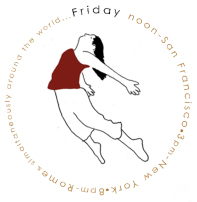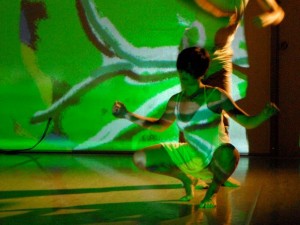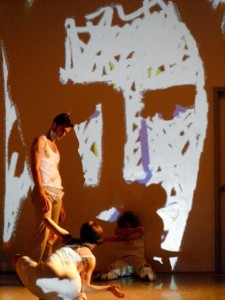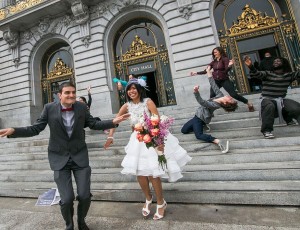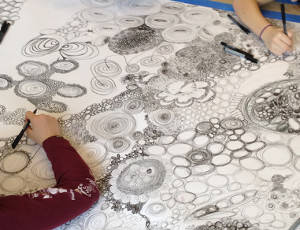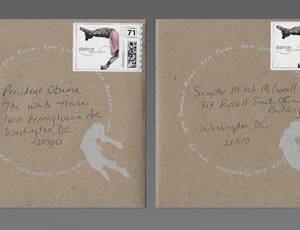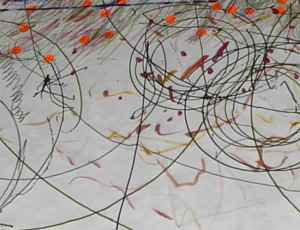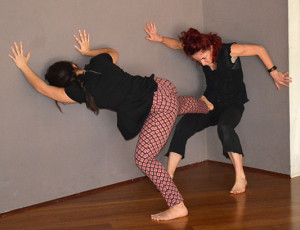Mother Tongue is a collaborative performance featuring the choreography of Kara Davis, visual media artist Hussein Shakara and composer/istrumentalist Haggi Cohen-Milo. Combining their languages of origin, which are English, Arabic, and Hebrew, the trio assign each other a piece of text (which range from newspaper articles to Biblical texts) and the responses to these assignments are then performed on stage.
The responses rely heavily on improvisation, which are performed through various mediums which include musical pieces, dance, and spoken-word/performance art. The performance itself also includes three other musicians and three other dancers. The entire piece is acted out through “moments” that are choreographed and familiar to the performers, but the chronology is never the same and the reactions to each scene reflect this serendipity.
Perhaps the most visionary and unique aspect of Mother Tongue features Mr. Shakura’s touch-screen computer which he can draw on as he performs and then project onto the stage in real time, often on the bodies of the performers. In this way, the piece as a whole, encompasses many different arenas of creative expressions including dance, visual art, spoken-word, music, and composition. Mother Tongue does not only work to create an unforgettable experience for its audience, but is as consequential to those on stage, as it evolves into a different piece each time it is performed, taking on new meaning and creating new inspiration.
Kara Davis, choreographer of Mother Tongue took some time out to answer some questions about her collaborative new piece which is both unconventional and extraordinary.
What is it like to try to choreograph such a complex performance, that seems to take off in every different direction moment to moment?
In the case of this piece, the main intention is to be aware that there are three art forms being represented and to stay committed to the present moment. Mostly, the challenge for all of us has been knowing when NOT to do anything so that different details can emerge and expand, and ultimately lead the piece through it’s journey through time and space. The challenge as a “choreographer”, as with all structured improvisations, has been to establish enough structure for everyone to collectively understand and bounce against that, at the same time, isn’t suffocating in it’s demands. All of the artists involved wanted to create something similar to life – humans have imposed or self-created structures that they use or resist every day in life: the time of waking up, going to work, having lunch, reading the news, going to sleep, etc. What happens in between those markers in the day are improvised. We wanted to create a similar structure for ourselves with this piece. Language holds structure, the disciplines of art hold structure, and walls (both internal and external) hold structure. All three of things are both responsible for creating meaning and clarity in life, yet at the same time can be destructively dividing. We were all interested in the tension that exists between structure and chaos.
What is the most difficult thing about trying to make Mother Tongue semi-cohesive?
Being patient enough to recognize when things organically emerge that feel resonant, embracing the present moment – not attaching oneself to any one particular of the piece; in other words, not trying to recreate a past situation that felt powerful and instead maintaining an energetic connection to one another so that other “powerful” things can emerge, and making sure that all the art forms share an equal voice within the performance.
Do you find that mixing the different languages of origin make for a more chaotic response? How do you assign each composition for the performances?
This piece is really in its genesis; to be honest, we haven’t worked as much on the text that we will use. The words that will be used and spelled out visually are the Arabic word “enshallah” (or “God- Willing” – in context it is used to express “hopefully”), the words “temperature” and “approximately” spelled in English, Hebrew and Arabic. Mostly these words have been chosen because they are words that measure the texture of space, quantity of time, and an internal notion of faith. The next step in this process will be to really converse about which words feel most resonant inside this work; we have mostly focused on how to connect with one another creatively as we improvise together and let this conversation speak its own language. So far the beginning is set: the musicians play for 5-10 minutes, Hussein begins to respond to them and then ultimately draws an anatomical hand, a dancer enters and fills in the projection of the hand with the shadow of her hand, the other two dancers enter and do a structured improvisation based on a movement phrase, somewhere in the piece Hussein builds a portrait using the shadows cast by the dancers, and the piece ends when all of us collectively understand it is over – this is one of the hardest things about improvising: knowing when the ending has happened THE FIRST TIME!!! There isn’t a hard and fast rule to determine this, but it requires that nobody drift off into their own self-indulgent world, which is always a temptation!
How did you choose your dancers and musicians? What are your most prominent forms of dance and type of instrument?
Alex and Adam (dancers) have both been students of mine at the LINES BFA and Training Program and have danced with project agora in various capacities over the past three years. Along with their physical beauty and technical proficiency, both of them are invigorated and truly curious about improvisation. I admire and am inspired by their creative impulses, I trust their artistry, and love dancing with them. Haggai and I met in Tel Aviv for 30 minutes (he met my friend on a plane and then took her out on a date). Two years later he had moved to San Francisco from Boston and serendipitously attended a project agora concert at Dance Mission. He had newly arrived and had worked extensively with dancers all throughout his early youth and was eager to dive into the dance scene in San Francisco. There was just an incredible connection between the two of us from the beginning – he would come to my rehearsals and say a couple words that would make everything clear for me. When I would listen to his compositions the same thing would happen. It was instant trust and respect for the creative voice of the other, which is so rare. We weren’t afraid to be truly critical of one another and the criticism never came from a competitive place but rather a thirst to give the other a perspective they may not have considered before. My husband Hussein had attended a dancer-musician improvisation jam that I hosted for 4 years and was jealous because he wanted to participate. He bought his touch-screen computer and we started experimenting with it. Haggai and Hussein had the same connection with one another so this piece felt like it organically came together. The improvisation is based on a phrase of choreography that I made which was influenced by and is a hybrid of all the dance forms I have studied in my career: Forsythe improvisation modalities, Gaga, classical ballet, release technique, and the Budo practice developed by Akira Hino. The musicians all studied at the Berkeley School of Music in Boston, Hussein studied visual art and graphic design in Cairo, Egypt.
What have been some of the reactions from the audience? Are there any particular scene-stealers?
I think when the audience knows something is an improvisation, they enter experiencing it with a different sensibility. The last couple times we have performed the piece the audience was mostly people in the visual arts community which was really refreshing for the musicians and the dancers. many people responded by saying that the piece was very meditative and that they felt fully engage observing landscapes and textures being pulled into different places from all of us working together. There are no particular scenes; our hope as performers is that the connection between the three mediums of expression is the ultimate “scene stealer!”
project agora performs “Mother Tongue” with Moontit (Haggai Cohen Milo, Mateo Lugo, Daniel Wright) accompanied by live visual artist Hussein
Shakara. Friday October 14, 9 pm, 66 Sanchez St, San Francisco, Ca $10
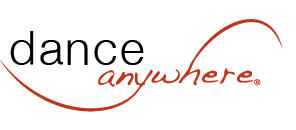
 Sign In
Sign In